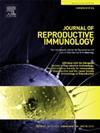Human embryo implantation: The complex interplay between endometrial receptivity and the microbiome
IF 2.9
3区 医学
Q3 IMMUNOLOGY
引用次数: 0
Abstract
The endometrial and vaginal microbiota have co-evolved with the reproductive tract and play a key role in both health and disease. However, the difference between endometrial and vaginal microbiota, as well as their association with reproductive outcomes in women undergoing frozen embryo transfer, remains unclear. 120 women who underwent in vitro fertilization (IVF)/intracytoplasmic sperm injection (ICSI) and whole embryo freezing were enrolled. The vaginal and uterine microbiome were sequenced during the first frozen thawed embryo transfer. Based on whether or not they were pregnant after embryo transfer, women were assigned into two groups, and the microbiome of their reproductive tract was compared. The V3-V4 regions of the 16S rRNA gene were examined in the samples using the Next Generation Sequencing method. In the vagina, the non-pregnant group had higher bacterial species richness and diversity, with significantly lower Lactobacillus levels (91.66 % & 74.50 %) and higher Gardnerella levels (3.92 % & 12.12 %) than pregnant group (P < 0.05). In the uterine cavity, the diversity of uterine microbiome between pregnant group and non-pregnant group showed no significant differences. However, dramatic decrease in Lactobacillus (37.27 % & 33.45 %) and Pseudomonas (9.80 % & 4.08 %) were observed in the non-pregnant group (P < 0.05). There may be a correlation between the composition of female reproductive tract microbiome and the reproductive outcomes of patients with frozen-thawed embryo transfer. Lactobacillus-dominated microbiome in reproductive tract is more likely to be associated with higher clinical and ongoing pregnancy rate.
求助全文
约1分钟内获得全文
求助全文
来源期刊
CiteScore
6.30
自引率
5.90%
发文量
162
审稿时长
10.6 weeks
期刊介绍:
Affiliated with the European Society of Reproductive Immunology and with the International Society for Immunology of Reproduction
The aim of the Journal of Reproductive Immunology is to provide the critical forum for the dissemination of results from high quality research in all aspects of experimental, animal and clinical reproductive immunobiology.
This encompasses normal and pathological processes of:
* Male and Female Reproductive Tracts
* Gametogenesis and Embryogenesis
* Implantation and Placental Development
* Gestation and Parturition
* Mammary Gland and Lactation.

 求助内容:
求助内容: 应助结果提醒方式:
应助结果提醒方式:


